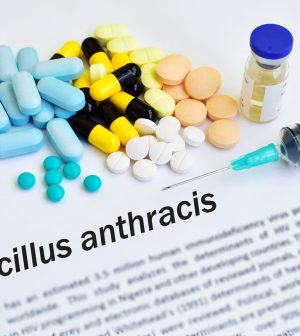- How Daily Prunes Can Influence Cholesterol and Inflammation
- When to Take B12 for Better Absorption and Energy
- Epsom Salts: Health Benefits and Uses
- See What Saffron Can Do for Sleep and Heart Health
- 6 Common Mistakes to Avoid Before Your Physical
- Can Sweating Really Help You Beat a Cold?
- Strengthening Your Relationship: Practical Strategies
- Skip Storing This Everyday Product in the Fridge Door
- Green Tea + B3 Pairing May Boost Brain Health
- Navigating Your Midlife Crisis: Embracing New Possibilities
Texas Rancher Developed Anthrax From Butchered Lamb Meat

Anthrax disease in humans is rare and when it does occur, it’s usually during hot, dry summers.
That’s why the case of a Texas rancher who developed anthrax in January of this year piqued the interest of investigators at the U.S. Centers for Disease Control and Prevention.
The rancher, who survived his ordeal, caught the anthrax germ after butchering and consuming meat from a lamb that had died unexpectedly on his ranch, reported a team led by CDC investigator Cari Beesley.
The take-home message from this case: “Processing animals that die suddenly from unknown causes should be avoided, irrespective of the season,” the researchers advised.
The case began with the rancher first consulting his doctor on New Year’s Day about infected skin wounds that were found to be resistant to treatment with standard antibiotics.
By Jan. 4, the man arrived at a hospital with fever, a high white blood cell count, a scabrous lesion on his right wrist and a swollen right arm complete with “blistered lesions.”
Based on those symptoms, doctors suspected anthrax, which can be a risk for folks working with livestock. The man was transferred to a second hospital, where more intensive testing could be done.
Swabs of the infected wounds tested positive for B. anthracis DNA, the CDC team reported.
After extensive treatment with antibiotics the illness resolved; the patient was discharged from the hospital on Jan. 12.
Further investigation pinpointed a recently deceased lamb as the probable source of the man’s infection.
“On December 24, 2023, he had butchered a lamb that had died suddenly on his ranch, located in a Texas county adjacent to a region with enzootic [found in animals] anthrax, known as the ‘Anthrax Triangle,'” Beesley’s team reported June 6 in the CDC journal Morbidity and Mortality Weekly Report.
The lamb had appeared healthy shortly before its unexpected death, the CDC noted.
“The patient and another person seasoned and cooked the meat; the well-cooked meat was then consumed at a meal with three other persons,” the investigators said, but only the man who butchered the lamb became ill.
That suggests direct contact between the deceased animal and the man’s skin as the mode of transmission. In this case and prior human anthrax cases recorded in the same area of Texas, “the patients reported direct skin exposure to animal carcasses, emphasizing the importance of avoiding processing carcasses of animals that unexpectedly die of unknown causes in this region regardless of the season,” the investigators said.
Tests of leftover cooked and frozen meat from the lamb did not show up as positive for the anthrax germ.
However, “the infecting bacteria possibly were inactivated when the meat was cooked at high temperatures,” the researchers said.
In any case, “there is no safe way to prepare meat for human consumption from an animal that has died of anthrax,” they added.
Anthrax outbreaks such as these can be avoided, Beesley and her team noted.
“Routine anthrax vaccination of animals is needed in this geographic region with known enzootic anthrax,” they said.
More information
Find out more on anthrax at the U.S. Food and Drug Administration.
SOURCE: Morbidity and Mortality Weekly Report, June 6, 2024
Source: HealthDay
Copyright © 2026 HealthDay. All rights reserved.










